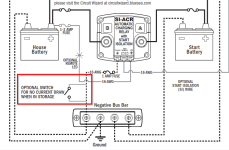SlipperyOar
Petty Officer 3rd Class
- Joined
- Apr 12, 2024
- Messages
- 75
I am looking into adding an ACR or an 1/2/B switch to my current electrical system. I've been reading lots into the BlueSea ACR system and the ease of installation and reliability behind it. I've also seen how a make-before-break 1/2/B switch can do the same job, with the risk of forgetting to turn off the Both connection before starting and risk of the switch become faulty with a broken connection before going to both batteries. My rectified regulator on my E100TLCSC is the CDI 193-3408 with 10 amp charging and automatically regulates the voltage, stopping charging at 14.1 volts which only will recharge my starter battery.
My question is, if i were to add the ACR into my system, do i need to disconnect the MinnKota 2-bank battery charger to my house battery and allow the charging to happen through the starter battery and ACR to charge both batteries? What is the best method to recharge my house and starter while underway.
I am mainly interested in having the most reliable, safe, issue free way to maintain the house battery while i am out fishing. My starter battery charges nearly instantly back to full voltage but my house battery becomes weaker as the day goes on. I always leave my MinnKota plugged in while my boat is parked. My plan would be to periodically start my main motor while trolling on my kicker to recharge my house battery or allow all the short hops i do while jigging to do the trick.
I have attached my current battery setup, and how i would integrate the ACR system and 1/2/Both switch.
My question is, if i were to add the ACR into my system, do i need to disconnect the MinnKota 2-bank battery charger to my house battery and allow the charging to happen through the starter battery and ACR to charge both batteries? What is the best method to recharge my house and starter while underway.
I am mainly interested in having the most reliable, safe, issue free way to maintain the house battery while i am out fishing. My starter battery charges nearly instantly back to full voltage but my house battery becomes weaker as the day goes on. I always leave my MinnKota plugged in while my boat is parked. My plan would be to periodically start my main motor while trolling on my kicker to recharge my house battery or allow all the short hops i do while jigging to do the trick.
I have attached my current battery setup, and how i would integrate the ACR system and 1/2/Both switch.




















